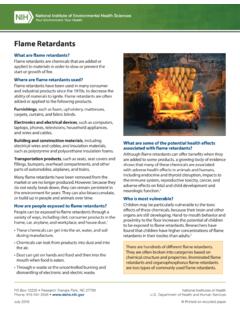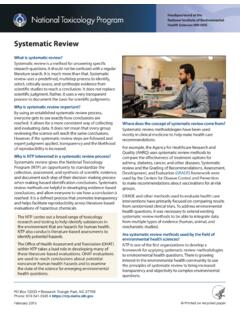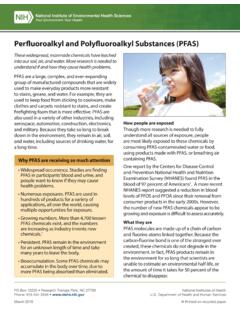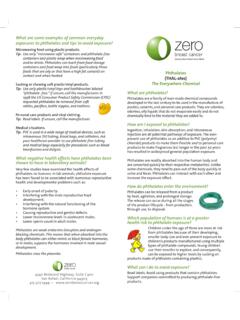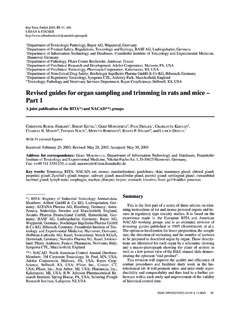Transcription of An Introduction to Implementation Science for ...
1 National Institutes of Health Department of Health and Human ServicesAn Introduction to Implementation Science for Environmental HealthLindsey Ann Martin, PhDHealth Scientist AdministratorPopulation Health BranchNational Institute of Environmental Health SciencesWhat is Implementation Science ? Implementation Science (IS) is the study of methods to promote the adoption and integration of evidence-based practices, interventions, and policies into routine health care and public health settings to improve our impact on population of Implementation Science the gap 17 Years Recognition of: Research to practice gap in health care: moving scientific evidence into real-world settings has taken a lot of time (Balas& Boren 2000, Grant et al. 2003, Morris et al. 2011). Effectiveness does not always equal public health impact (Bauer & Kirchner 2020) Implementation Science is focused on the HOW question: how can we move interventions, practices, and policies into real-world settings like health care systems, communities impacted by environmental exposures?
2 A simple way to think about Implementation The intervention/practice/innovation is THE THING Effectiveness research looks at whether THE THING works Implementation research looks at how best to help people/places DO THE THING Implementation strategies are the stuff we do to try to help people/places DO THE THING Main Implementation outcomes are HOW MUCHand HOW WELL they DO THE THING Geoffrey Curran (2020) Implementation Science Made Too Simple: A Teaching Tool. Implementation Science CommunicationsA hypothetical example: You are working with a fencelinecommunity impacted by high levels of air pollution coming from a petrochemical plant (PM, VOCs) there are extremely high rates of childhood asthma This Photoby Unknown Author is licensed under CC BYThe Thing : An educational toolkit to help parents teach their children about what is in the air, how it affects their health and steps to mitigate exposure ( , not playing outside during peak exposure hours) This Photoby Unknown Author is licensed under CC BYEffectiveness (testing the thing ).
3 Parents felt their children s awareness about air pollution and its link to asthma increased parents report that their children are more likely to stay inside during peak exposure hours health care data shows that asthma exacerbation rates have declined for children in this community the thing works!This Photoby Unknown Author is licensed under CC BYImplementation: You then use the the thing in another fencelinecommunity, but parents do not feel that their children understand the link between air pollution and asthma -children are not staying inside during peak exposure hours - asthma exacerbation rates have not declined. There is some barrier (or barriers) that prevent parents in this community from using the thing This Photoby Unknown Author is licensed under CC BYImplementation Strategies: Implementation Science can help you identify these barriers and identify/test strategies that can help the parents in this community use the thing you build a community advisory board and hold educational meetings ( , identify strategies) to help parents in this community use the thing This Photoby Unknown Author is licensed under CC BYImplementation Strategies(Powell et al.)
4 2015, Waltz et al. 2015) What barriers are you trying to overcome? What resources are you able to leverage? Who are your stakeholders?Slide courtesy of Gila Neta, NCII mplementation (vs. Effectiveness) Outcomes(Proctor et al. 2011)Hybrid Designs: Enhancing Translation Potential Hybrid 1: Effectiveness Implementation Hybrid 2: Effectiveness - Implementation Hybrid 3: Implementation EffectivenessCurran et al. (2012). Effectiveness- Implementation hybrid designs: combining elements of clinical effectiveness and Implementation research to enhance public health impact Med Care. Context Matters! SocioecologicFramework (see Tabak et al. 2013): Individual; Community; Organization; & System- , Models and Frameworks (Nilsen 2015) Process Models Guide the Implementation process Determinant Frameworks Implementation outcomes are impacted by barriers and facilitators Evaluation Frameworks Help researchers frame Implementation successWhy does Implementation Science Matter for Environmental Health?
5 A Case StudyClean Cooking Implementation Science Network (ISN) Public Health Issue: Millions of deaths from household air pollution (HAP) biomass stoves - open fire use in low- and middle-income countries Women, children, poor disproportionately affected Need for uptake and sustained use of clean cooking methods ( , liquid petroleum gas [LPG]) Multi-level barriers to Implementation of clean cooking: fuel characteristics, household characteristics, knowledge/perceptions, affordability, supply chain, regulations and policies to support clean cooking Implementation of multi-sectoral and multi-level interventions are neededThis Photoby Unknown Author is licensed under CC BY-NC-NDRosenthal et al. 2017 Clean Cooking Implementation Science Network (ISN) Implementation Science Questions: How can clean cooking ( , the intervention or the thing ) be implemented? Household and community level adoption: what adoption level is needed to impact health outcomes?
6 Stakeholder perspectives: what do households need for cooking? What can these perspectives tell us that will help Implementation ? What Implementation strategies are needed to support the uptake of clean cooking interventions?This Photoby Unknown Author is licensed under CC BY-NC-NDRosenthal et al. 2017 Affordability, Accessibility, and Awareness (3As)(Kumar et al. 2020)What determinants impact the adoption of LPG in rural India? Affordability:income is one determinant as higher income LPG adoption Accessibility:Biomass ( , wood) availability a barrier to LPG adoption rural women collect the biomass and prioritize it over alternatives Awareness:adoption impacted by concerns about LPG safety/explosions awareness campaigns a key strategy to support LPG adoption in poor householdsPhotovoice and LPG Adoption (Ronziet al. 2019)What are the community perceptions of LPG adoption in South-West Cameroon?
7 Barriers: affordability of equipment/refills, transportation costs for refills/distance, safety ( , plank houses), lack of LPG shops Facilitators: greater awareness LPG health benefits, more shops in rural areas, increasing safety, lowering cost of refills Photo exhibition as advocacy involved government ministries and other stakeholders (LPG marketers, media, community members/leaders) Community perceptions highlight multi-level barriers to uptake individual-level factors ( , awareness) and regional/national-level factors ( , costs)For more on the Clean Cookstove ISN: Science and Health equity equity is the state, quality, or ideal of being just, impartial, and fair. The concept of equity is synonymous withfairness and justice . To be achieved and sustained, equity needs to be thought of as a structural and systemic concept. [emphasis added]Audrey Loper, BeadsieWoo & Allison Metz: equity is Fundamental to Implementation Science .
8 Supplement to Stanford Social Innovation Review, Summer 2021 ( ) Advancing Environmental Health equity at NIEHSI mage Credit: Liam O Fallon & Melissa Smarr (NIEHS) Implementation Science10 Recommendations to Advance Equitable Implementation Build Trusting the time to build trust through small, frequent interactionsDismantle Power the solo leader model of Implementation information and decision-making authority to those whose lives are most affected by the Implementation Invest and Make Decisions to Advance in deliberate and transparent community members in interpreting and using data to support implementationAllison Metz, BeadsieWoo & Audrey Loper: Equitable Implementation at Work. Supplement to Stanford Social Innovation Review, Summer 2021 ( ) 10 Recommendations to Advance Equitable Implementation ContinuedDevelop Community-Defined interventions with community membersMake Adaptations [including cultural adaptations] locally based service delivery issues of social justice [systemic & structural racism]Critical Perspectives on Implementation Implementation strategies that address the contextual factors that contribute to disparities in long-term outcomes that advance equityAllison Metz, BeadsieWoo & Audrey Loper: Equitable Implementation at Work.
9 Supplement to Stanford Social Innovation Review, Summer 2021 ( ) Structural Racism & Implementation Science Recommendations of structural racism in Implementation Science theories, models, frameworks and measures approaches: select, develop and implement interventions and Implementation strategies to address structural racism and intersectoral collaborations and engagement as essential Implementation Science methodsShelton RC, Prajakta A, Oh A. Recommendations for Addressing Structural Racism in Implementation Science : A Call to the Field. EthnDis. 2021;31(Suppl 1): 357-364 10 Key IngredientsProctor et al. 2012 Adapted for Environmental Health#1 The Gap What is the environmental public health gap that you are addressing in the proposal? How will the Implementation of this intervention, innovation, practice ( , the thing ) reduce this gap? Review criteria: Significance, Impact #2 The Evidence-Based Intervention, Innovation or Policy Have you provided evidence that the intervention, innovation, practice ( , the thing ) works?
10 Establishing readiness of the thing prior effectiveness research literature review to establish the evidence base Review criteria:Significance, Innovation#3 Conceptual Model & Theory What Implementation Science theories, models and frameworks are you using? Clearly show how these are linked to your research design and variables Review criteria: Approach, Innovation#4 Stakeholder Priorities-Engagement in Change Who are your stakeholders? How have you demonstrated their engagement in this study? (think beyond letters of support) Is your stakeholder engagement equitable? Have you considered power imbalances? Review criteria: Significance, Impact, Approach, Environment#5 Readiness to adopt the intervention, innovation, policy Is the setting, community, etc., ready for the intervention, innovation, practice ( , the thing )? What evidence have you provided that the setting will adopt the thing ?


